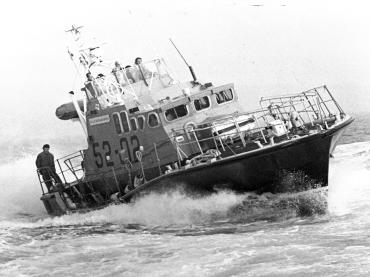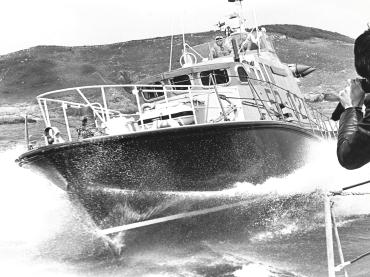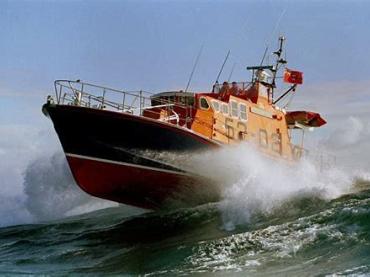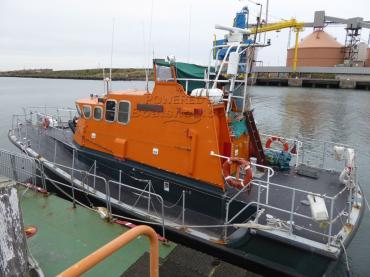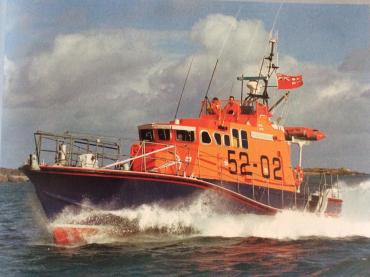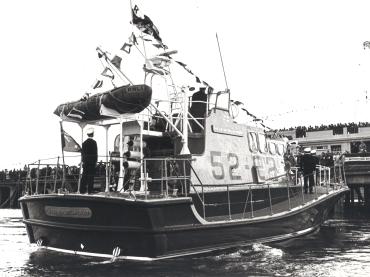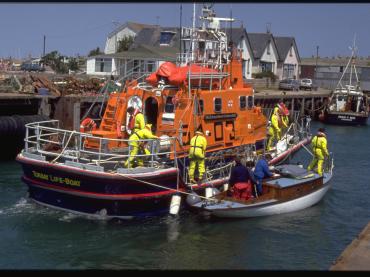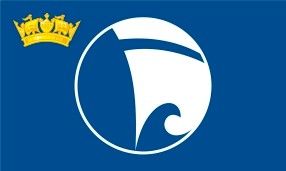
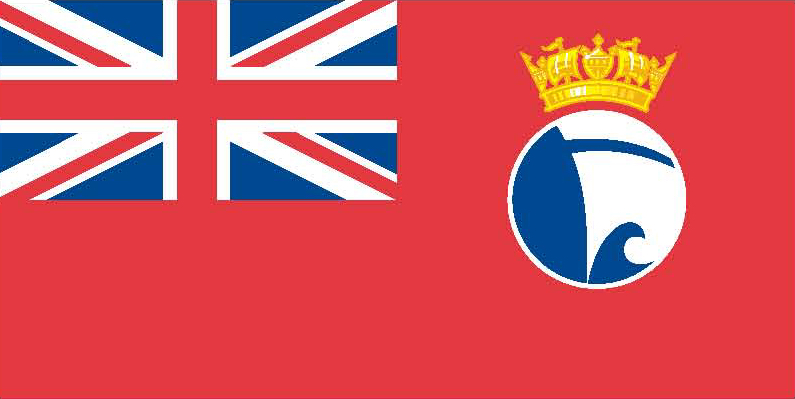
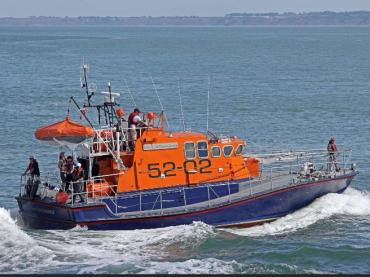
Previous names
- 1973 - 1974 LIFEBOAT 52-02
- 1974 - 1997 SIR WILLIAM ARNOLD
- 1997 - 2022 THEOCRAT, OUR LADY, and SAMUEL J
Details
Construction
Dimensions
History
SIR WILLIAM ARNOLD (ON-1025) is one of the most iconic looking and famous lifeboats in the history of the RNLI. Highly regarded & respected by her volunteer crews from the island of Guernsey, this prototype became the forerunner of today’s modern all-weather lifeboat. She was involved in some dramatic and heroic rescues during her lifesaving career spanning three decades; launching over 500 times and saving 223 lives. She is also probably one of the most decorated lifeboats in the RNLI, earning her coxswain’s and crew a total of fifteen RNLI gallantry medals and an array of awards for gallantry from around the world.
In the 1970s, the RNLI had been developing a new faster class of lifeboat to replace an ageing fleet of 8-knot boats. After a fundraising campaign in Guernsey, the local RNLI branch raised over £50,000 – approximately £1 for each Guernsey resident – for the construction of SIR WILLIAM ARNOLD by William Osborne of Littlehampton, West Sussex. The vessel arrived as LIFEBOAT 52-02 at St Peter Port, Guernsey, on 6th November 1973, and shortly after was launched for the first time to aid the 55ft Yacht THE LORD TRENCHARD. On 23rd May 1974, she was named SIR WILLIAM ARNOLD by HRH The Duchess of Kent, after Sir William Arnold, Vice-President of the fundraising branch and Bailiff of Guernsey, who sadly passed away before he could see the vessel in action.
Between 1973 and 1997, SIR WILLIAM ARNOLD served from Guernsey and was active in several lifesaving launches. The rescue of the BONITA in December 1981 was by far the most famous rescue in this lifeboat’s career when, battling a Force 12 hurricane, darkness, and seas of 40 feet in height, the crew of the SIR WILLIAM ARNOLD rescued 29 people from the Ecuadorian vessel sinking out in the English Channel. Throughout her years of service, the vessel was loved and hugely respected by her coxswains and crew and to this day is still widely accepted as one of the greatest lifeboats the RNLI built. The people of Guernsey fondly referred to her as “their lifeboat”.
In 1997, SIR WILLIAM ARNOLD was retired and sold out of service, being replaced by the Severn-class lifeboat SPIRIT OF GUERNSEY. Between 1997 and 2019, she was known by three different names: THEOCRAT, OUR LADY, and SAMUEL J. At some point, she was used as a pleasure vessel in Ireland, and after that as an all-weather lifeboat for the Blyth Independent Rescue organisation. Following the charity’s ceasing of operations, she was purchased in 2019 by her current owner, an enthusiast who, after survey and sea trials, was sailed from Newcastle to Amble, where she was lifted out and properly inspected. Following this, a restoration process began, converting her back to her lifeboat days.
Between February and March 2020, SAMUEL J was sailed to Heybridge Basin, Essex, where she remained for some time before moving to St Katharine Docks, London. There, in June 2022, she was renamed SIR WILLIAM ARNOLD with special permission of the RNLI and the blessing of the Arnold Family and dedicated by the Dean of Guernsey and the Chaplain of the Tower of London. At the ceremony, a commemorative plaque aboard the vessel was unveiled by HRH Duke of Kent, President of the RNLI, and two survivors from the BONITA rescue were reunited with former coxswain Mike Scales, flying over from Norway and Guernsey, respectively.
In 2024, she is planned to set sail from Heybridge Basin, Essex to her new home in the Isle of Wight, and on May 19th she will be present at the RNLI’s 200-year celebrations at Poole.
Significance
- What is the vessel’s ability to demonstrate history in her physical fabric?
Evidence for designs, functions, techniques, processes, styles, customs and habits or uses and associations in relation to events and people. How early, intact or rare these features are may impact on significance.
SIR WILLIAM ARNOLD was designed as an Arun class lifeboat, with a transom stern and semi-displacement hull, resulting in a faster type of vessel developed to replace the traditional 8 knot craft. The design was drawn up for the RNLI by J.A. MacLachlan working for naval architects GL Watson of Glasgow and then refined by the RNLI following the prototype trials. She was constructed of wood, triple laid for extra strength and fitted with an aluminium wheelhouse. As the second in her class, adaptations were made based on trials undertaken with the first of the design. SIR WILLIAM ARNOLD was given a lower freeboard aft than her predecessor to facilitate recovering survivors from the water, giving her barely 3 feet of freeboard amidships. Her wheelhouse gave two separate cabins above deck and was fitted with a forward raked wheelhouse windscreen and a unique wheelhouse side window pattern. She retained the aft mounted flying bridge. A small inflatable lifeboat was carried for shallow water rescue, initially on the aft deck, but later on a gantry to the rear of the wheelhouse, launched by a crane. Her engines were uprated to give enhanced performance and she was fitted with twin Caterpillar 6-cylinder diesel engines which she retains today. Having undergone adaptation since leaving service and subsequent reconstruction work, she has been repainted in her original blue and any missing pieces of technology have been re-fitted or replaced with similar examples. She was the first lifeboat to have a chart plotter added and the original survives in situ.
- What are the vessel’s associational links for which there is no physical evidence?
Associations with people or places. Off-ship research.
SIR WILLIAM ARNOLD, originally numbered Lifeboat 52-02, was the second Arun-class lifeboat built by William Osborne at Littlehampton and served as the Guernsey lifeboat for 24 years. She has strong associations with the island having been funded by a local campaign and named after the Bailiff in a ceremony involving the Duchess of Kent. Rescues of international shipping included that of the Greek ship CANTONAD in 1979, the Liberian freighter RADIANT MED in 1984 and the French yacht MATAM in 1985. Her most significant rescue was the Ecuadorian cargo vessel BONITA in 1981, when 29 people were saved from the sinking vessel in a force 12 gale for which RNLI gold and bronze medals were awarded. In later life, she was used as the all-weather lifeboat for the Blyth Independent Rescue organisation. SIR WILLIAM ARNOLD was launched over 500 times and saved 223 lives. She is one of the most decorated lifeboats in the RNLI, earning her coxswains and crew a total of 15 gallantry medals and an array of awards from round the world. She was featured as the 25p stamp in a series of six Guernsey post stamps issued in 1999 for the 175th Anniversary of the RNLI. SIR WILLIAM ARNOLD was recorded on the National Register of Historic Vessels in 2023.
- How does the vessel’s shape or form combine and contribute to her function?
Overall aesthetic impact of the vessel, her lines, material she was built from and her setting. Does she remain in her working environment?
SIR WILLIAM ARNOLD was built as a fast all-weather lifeboat and was an iconic and distinguished looking vessel in her distinctive RNLI livery. Her twin Caterpillar engines enabled her to reach speeds of 19 knots, with fuel tanks having a 620 imperial gallon capacity, giving her the range of 250 nautical miles for which she was designed. She is now maintained in operational condition and open to the public, based in Heybridge Basin, Essex.
Source: NHS-UK team, March 2024
Key dates
- 1973 Lifeboat arrives at St Peter Port, Guernsey
-
1974
SIR WILLIAM ARNOLD named by HRH Duchess of Kent in Guernsey
-
1975
Service to the Tanker POINT LAW, with Bronze Medals awarded to Coxswain John Petit and Crewman John Robbilliard
-
1977
Service to the yacht CANOPUS, with a Bronze Medal awarded to Coxswain John Petit
-
1979
Service to the Greek freighter CANTONAD, with a Bronze Medal awarded to Coxswain John Petit
-
1981
Service to M.V. BONITA, with 29 people rescued in a Force 12 hurricane. Gold Medal awarded to Coxswain Mike Scales, Bronze Medals awarded to crewmembers Peter Bougourd, Robert Vowles, Peter Bisson, John Bougourd, John Webster, Richard Hamon, and Alan Martel
-
1984
Service to the Liberian freighter RADIANT MED, with 9 people rescued. Bronze Medal awarded to Coxswain Mike Scales
-
1985
Service to the French Yacht MATTAM II, with Bronze Medal awarded to Coxswain Peter Bisson
-
1992
Service to the Yacht SENA SIORIA, with 9 people rescued including 3 by rescue helicopter. Silver Medal awarded to Coxswain Peter Bisson
-
1997
SIR WILLIAM ARNOLD retires from operational service and is sold out of service, being replaced by the Severn-class lifeboat SPIRIT OF GUERNSEY
-
2019
Current owner purchases ON 1025 and restores her back to how she was was in operational service
-
2022
SIR WILLIAM ARNOLD is renamed and dedicated by the Dean of Guernsey and the Chaplain of the Tower of London at a memorable service at St Katharine Docks, London. Commemorative plaque unveiled by HRH Duke of Kent (President of the RNLI) (now on board the Lifeboat). Two survivors of the 1981 BONITA rescue meet after 40 years with the coxswain that rescued them, Mike Scales
Own this vessel?
If you are the owner of this vessel and would like to provide more details or updated information, please contact info@nationalhistoricships.org.uk

